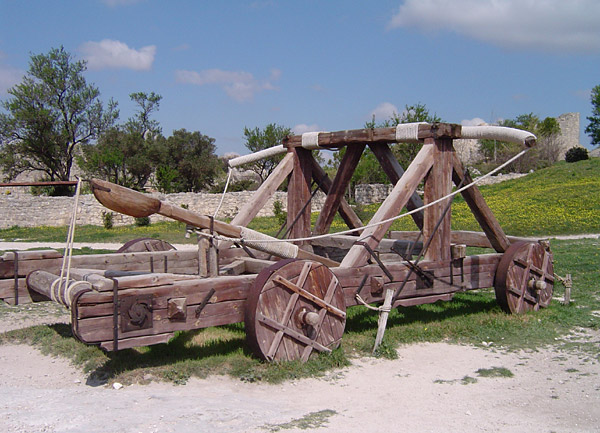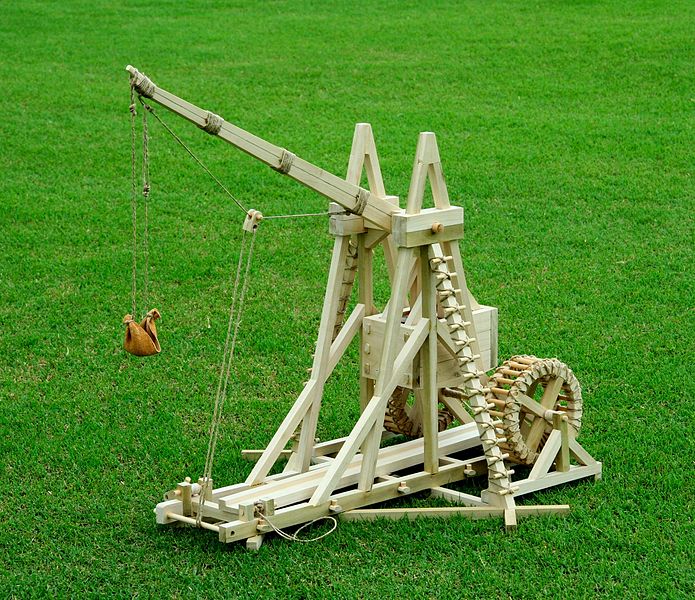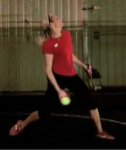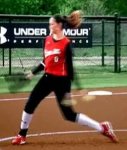I was going to post something on two threads I found interesting…”best ways to increase pitch speed” and “the real deal”. Time has been a factor though..so let me throw this out here on its on all together.
So far here is the list of recommendations from the best ways to increase pitch speed on that thread.
1. Mechanics
2. Lower body strength and core strength.
3. Push harder off rubber
4. Mental toughness
5. Doing everything faster
6. Standing on one leg pitching
7. Three oclock throws, Long toss, Rapid speed throws
Since increased arm rotation speed is on our list of goals…for this off season…I want to show…how we are looking at it…and see if others have done this as a measuring tool….if my times seem right or if its all off base.
From what I see…Arm speed has a lot to do with it (speed)…as others said it isn’t all there is to it… because the arm swing is dependent on mechanics and lower body/core strength primarily. But arm rotation speed…seems to correlate specifically to ball speed…on the videos I have measured. I have yet to find a way to measure arm “whip”…but I would like to be able to. Someone that has that 300 frames per second video…might be able to give us some insights in that.
Prior to posting my dd and the questions in the other post on off season improvement. I had decided to measure arm rotation speed so we could set a goal and get more specific about training for that too. I did it in a way…that one of the hitting posters talked bout for bat speed…so we could measure it simply.
FiveFrameSwing…had spoke about getting the barrel moving to poc in five frames of a 30 frame per second video as a good marker in a post in the hitting section.
So…I measured frames on 30 frame per second video. I am not saying that I am exact in my measurements here and its limited to the videos I have… yet it does compare closely to the “cut 2/100ths of time off full rotation” to gain 5-6 mph that pitchsoftball.com talks about…and it correlated good across the board of pitchers I had video’d….enough that it seems useful enough for us (me & dd). Besides…something about those little time stamps and reading things in 100ths annoys me!
There were 10 good pitchers and 3 average pitchers…There were only 2 of them I actually seen clocked by radar…which is the problem here. Of all of them…only one of them was for sure near mid 60s. I was guess-stimating that the good pitchers were over 55, some were near 60 and the average were at to below 55 (Estimated speeds…since I didn’t have radar speeds of them)...and the guess’s here correlated good.
After seeing “the real deal” thread…I looked at things again adding Tori Funicane. Tori Funicane’s arm speed was just amazing to me for her age. All I could say was wow. Didn’t think I would see much faster than the fastest girl I had video’d live...who is at 64mph…who is the fastest I seen the last two years.
I used frame counts starting at 9 oclock position (arm/ball pointed to catcher) to release… because the 6 oclock to 9 oclock up swing… didn’t seem to make a difference. All of the pitchers took 3 to 4 frames to get from 6 oclock to 9 oclock …regardless of their speed...including Tori at 3. Since the other girl was at 4 and still threw 64 mph…and the slower pitchers were all at 4 too and most the good pitchers were at 4, one was at 3…the up swing from 6 oclock to 9 oclock is not where I wanted to spend our energy/focus…at least at this point.
For new pitching dads/moms…I think this is important… as I remember back when we started… thinking the whole point of the swinging the ball back…was to get momentum of the arm going forward to get faster arm speed going up. That does not seem to be the case and is why you can swing arm back or launch from the side. It seems to play little to no role for increased arm rotation speed. I also noticed on some video when my dd would be told to “be quicker”…she was quicker in the back swing only…her intended effort didn’t occur during the important swing phases… as the frame counts remained the same from 9 to release. I wouldn’t have known that by eye sight as it looked like she was being quicker.
On the two pitchers I saw clocked and Tori’s video… here were some findings.
From 9 oclock to release
Girl A: Tori…said to be at 68… measure at just less than 6 to 6 frames from 9 oclock to release. Video gets a phantom arm on side view so hard to be exact but it is quick!
Girl B: Clocked at 64 mph consistently…measured at 6.5 frames or just under that. I thought this was the ultimate of quickness of arm rotation till I seen Tori’s…at these ages.
Girl C: Clocked at 56-57 mph…measured right around 7.5 frames.
My dd: Measured at just >8 to 8 frames at low 50s.
Measured from 9 to 12 oclock position they measured
Girl A: 2 frames
Girl B: 3 frames
Girl C: 3 frames
My dd: 3 frames
Maybe the up move is important here?
Measured from 12 to 3 oclock position
Girl A: 2 frames
Girl B: 2 frames
Girl C: 3 frames
My dd: 3 frames
This is significant as both girls near near 65 + mph…moved quickly thru this range.
Measured from 3 oclock to release
Girl A: just less than 2 to 2 frames, again video gets phantom arm here
Girl B: 1.5 frames
Girl C: 1.5 frames
My dd: 2 frames
Whats interesting here on video… is that Tori’s frame speed here was less than Girl B yet… Tori covered a lot more distance on this phase.
Also on this position… Girl B and C…are extremely fast thru here. However Girl C… does not slot the elbow as well as Girl B before pronation… Girl C brings her arm down rotating the upper arm a little early…yet when she pronates the forearm…it is really fast.
On the other side of the coin…one girl video’d I know throws low 50’s…had a 7.5 frame rate…yet…she bends a lot at the waist on release…which just confirms…that technique is important and more so than arm rotation speed. She may be able to throw upper 50’s just by stopping the bending if she can maintain the same 7.5 frame rotation speed.
Whether its specific enough or not…it gave me something to play with….and a couple focus points to set our goal and to be able to measure whether what we are going to do for arm rotation speed is doing anything or not.
IF this was standard correlation… enough as far as generalizations go…couldn’t we say?
SevenNHalfFramePitching…for upper 50’s.
SevenFramePitching… for 60 mph
SixNHalfFramePitching….for 64 or so?
SixFramePitching…If you’re a phenom like Tori...for upper 60’s
Our off season goal this year… for arm rotation speed… WAS initially…to get to 7.5 frame pitching.
Till I had another question…
Can my DD even rotate her arm…from 9 oclock to release…that fast without a ball? I asked her to do it without warming up…three rotations. She was at 7.25 frames from 9 to release. Again…that was interesting.
If she can do it without a ball and warm up…what keeps her from being able to do it while pitching? My thoughts were... that there were three primary things.
1. Technique…something with technique is restricting motion. (one of the main reasons I posted her in the other post for suggestions).
2. Strength lower body/core…the lower body-core is not yet strong enough for the forces applied to “it”…let alone the shoulder complex.
3. The upper body (primarily shoulder) reflex-stretch mechanisms and strength/muscle contraction speed… to handle the deceleration phase primarily (which I think is more important than the shoulder strength and strength of acceleration phase)… is not good enough to have MORE shoulder rotation speed.
So we changed our goal to 7.25 frame pitching from 9 oclock to release for off season.
I do not know whether someone can knock .75 of a frame off of rotation or not… but we are going to try. I really don’t see why not especially if she can do it without a ball. The suggestion from BoardMember on arm path and lower body contraction may allow the body to adjust that specific aspect of arm rotation speed with just those two things corrected…just like going to leaping automatically sped up arm rotation.
It seems easier to count frames on a 30 frames per second than to use milliseconds or hundredths and gives a general non specific way to compare arm rotation speed and ball speed…if this is close.
I do wish I had done this from the time she was little…to track the changes…that could have been interesting.
Has anybody measured along this line of thought …. enough to say its close?
Anybody know what their dd’s 30 frame per second…frame count is from 9 to release…and the mph she throws...if so state her age too? If it correlates close across a spectrum of pitchers…even ages….that would be interesting…if it doesn’t…we probably could learn something from the differences.
Sorry for the long post, but I am curious about this.
So far here is the list of recommendations from the best ways to increase pitch speed on that thread.
1. Mechanics
2. Lower body strength and core strength.
3. Push harder off rubber
4. Mental toughness
5. Doing everything faster
6. Standing on one leg pitching
7. Three oclock throws, Long toss, Rapid speed throws
Since increased arm rotation speed is on our list of goals…for this off season…I want to show…how we are looking at it…and see if others have done this as a measuring tool….if my times seem right or if its all off base.
From what I see…Arm speed has a lot to do with it (speed)…as others said it isn’t all there is to it… because the arm swing is dependent on mechanics and lower body/core strength primarily. But arm rotation speed…seems to correlate specifically to ball speed…on the videos I have measured. I have yet to find a way to measure arm “whip”…but I would like to be able to. Someone that has that 300 frames per second video…might be able to give us some insights in that.
Prior to posting my dd and the questions in the other post on off season improvement. I had decided to measure arm rotation speed so we could set a goal and get more specific about training for that too. I did it in a way…that one of the hitting posters talked bout for bat speed…so we could measure it simply.
FiveFrameSwing…had spoke about getting the barrel moving to poc in five frames of a 30 frame per second video as a good marker in a post in the hitting section.
So…I measured frames on 30 frame per second video. I am not saying that I am exact in my measurements here and its limited to the videos I have… yet it does compare closely to the “cut 2/100ths of time off full rotation” to gain 5-6 mph that pitchsoftball.com talks about…and it correlated good across the board of pitchers I had video’d….enough that it seems useful enough for us (me & dd). Besides…something about those little time stamps and reading things in 100ths annoys me!
There were 10 good pitchers and 3 average pitchers…There were only 2 of them I actually seen clocked by radar…which is the problem here. Of all of them…only one of them was for sure near mid 60s. I was guess-stimating that the good pitchers were over 55, some were near 60 and the average were at to below 55 (Estimated speeds…since I didn’t have radar speeds of them)...and the guess’s here correlated good.
After seeing “the real deal” thread…I looked at things again adding Tori Funicane. Tori Funicane’s arm speed was just amazing to me for her age. All I could say was wow. Didn’t think I would see much faster than the fastest girl I had video’d live...who is at 64mph…who is the fastest I seen the last two years.
I used frame counts starting at 9 oclock position (arm/ball pointed to catcher) to release… because the 6 oclock to 9 oclock up swing… didn’t seem to make a difference. All of the pitchers took 3 to 4 frames to get from 6 oclock to 9 oclock …regardless of their speed...including Tori at 3. Since the other girl was at 4 and still threw 64 mph…and the slower pitchers were all at 4 too and most the good pitchers were at 4, one was at 3…the up swing from 6 oclock to 9 oclock is not where I wanted to spend our energy/focus…at least at this point.
For new pitching dads/moms…I think this is important… as I remember back when we started… thinking the whole point of the swinging the ball back…was to get momentum of the arm going forward to get faster arm speed going up. That does not seem to be the case and is why you can swing arm back or launch from the side. It seems to play little to no role for increased arm rotation speed. I also noticed on some video when my dd would be told to “be quicker”…she was quicker in the back swing only…her intended effort didn’t occur during the important swing phases… as the frame counts remained the same from 9 to release. I wouldn’t have known that by eye sight as it looked like she was being quicker.
On the two pitchers I saw clocked and Tori’s video… here were some findings.
From 9 oclock to release
Girl A: Tori…said to be at 68… measure at just less than 6 to 6 frames from 9 oclock to release. Video gets a phantom arm on side view so hard to be exact but it is quick!
Girl B: Clocked at 64 mph consistently…measured at 6.5 frames or just under that. I thought this was the ultimate of quickness of arm rotation till I seen Tori’s…at these ages.
Girl C: Clocked at 56-57 mph…measured right around 7.5 frames.
My dd: Measured at just >8 to 8 frames at low 50s.
Measured from 9 to 12 oclock position they measured
Girl A: 2 frames
Girl B: 3 frames
Girl C: 3 frames
My dd: 3 frames
Maybe the up move is important here?
Measured from 12 to 3 oclock position
Girl A: 2 frames
Girl B: 2 frames
Girl C: 3 frames
My dd: 3 frames
This is significant as both girls near near 65 + mph…moved quickly thru this range.
Measured from 3 oclock to release
Girl A: just less than 2 to 2 frames, again video gets phantom arm here
Girl B: 1.5 frames
Girl C: 1.5 frames
My dd: 2 frames
Whats interesting here on video… is that Tori’s frame speed here was less than Girl B yet… Tori covered a lot more distance on this phase.
Also on this position… Girl B and C…are extremely fast thru here. However Girl C… does not slot the elbow as well as Girl B before pronation… Girl C brings her arm down rotating the upper arm a little early…yet when she pronates the forearm…it is really fast.
On the other side of the coin…one girl video’d I know throws low 50’s…had a 7.5 frame rate…yet…she bends a lot at the waist on release…which just confirms…that technique is important and more so than arm rotation speed. She may be able to throw upper 50’s just by stopping the bending if she can maintain the same 7.5 frame rotation speed.
Whether its specific enough or not…it gave me something to play with….and a couple focus points to set our goal and to be able to measure whether what we are going to do for arm rotation speed is doing anything or not.
IF this was standard correlation… enough as far as generalizations go…couldn’t we say?
SevenNHalfFramePitching…for upper 50’s.
SevenFramePitching… for 60 mph
SixNHalfFramePitching….for 64 or so?
SixFramePitching…If you’re a phenom like Tori...for upper 60’s
Our off season goal this year… for arm rotation speed… WAS initially…to get to 7.5 frame pitching.
Till I had another question…
Can my DD even rotate her arm…from 9 oclock to release…that fast without a ball? I asked her to do it without warming up…three rotations. She was at 7.25 frames from 9 to release. Again…that was interesting.
If she can do it without a ball and warm up…what keeps her from being able to do it while pitching? My thoughts were... that there were three primary things.
1. Technique…something with technique is restricting motion. (one of the main reasons I posted her in the other post for suggestions).
2. Strength lower body/core…the lower body-core is not yet strong enough for the forces applied to “it”…let alone the shoulder complex.
3. The upper body (primarily shoulder) reflex-stretch mechanisms and strength/muscle contraction speed… to handle the deceleration phase primarily (which I think is more important than the shoulder strength and strength of acceleration phase)… is not good enough to have MORE shoulder rotation speed.
So we changed our goal to 7.25 frame pitching from 9 oclock to release for off season.
I do not know whether someone can knock .75 of a frame off of rotation or not… but we are going to try. I really don’t see why not especially if she can do it without a ball. The suggestion from BoardMember on arm path and lower body contraction may allow the body to adjust that specific aspect of arm rotation speed with just those two things corrected…just like going to leaping automatically sped up arm rotation.
It seems easier to count frames on a 30 frames per second than to use milliseconds or hundredths and gives a general non specific way to compare arm rotation speed and ball speed…if this is close.
I do wish I had done this from the time she was little…to track the changes…that could have been interesting.
Has anybody measured along this line of thought …. enough to say its close?
Anybody know what their dd’s 30 frame per second…frame count is from 9 to release…and the mph she throws...if so state her age too? If it correlates close across a spectrum of pitchers…even ages….that would be interesting…if it doesn’t…we probably could learn something from the differences.
Sorry for the long post, but I am curious about this.








